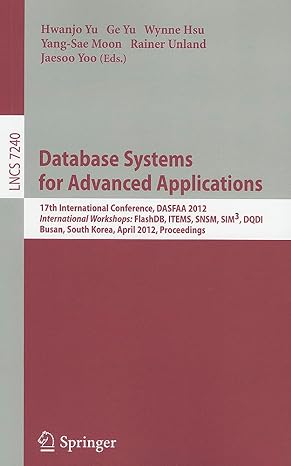Question
1 Compare Running Times of Mergesort and Quicksort Quicksort and mergesort are two divide and conquer algorithms that are used to sort a list. Quicksort
1 Compare Running Times of Mergesort and Quicksort
Quicksort and mergesort are two divide and conquer algorithms that are used to sort a list. Quicksort has a worst case performance complexity of O(no) while merge sort is O(nlogn). However, in practical cases, quicksort is able to be up to two or three times faster than mergesort. For the first task, compare and contrast the run times of naive mergesort and quicksort in with the provided files. How do they compare?
2 Cutoff Point That Results in Fastest Timsort
A popular sorting algorithm that is used as the default sort for the python and java languages is Timsort. It is a hybrid algorithm that uses both insertion sort and merge sort. The general idea is that because splitting a list into two parts and calling a new function recursively is relatively expensive in terms of ram and computation, merge sort is first used to divide the list into smaller sub lists. Then, when the threshold where insertion sort is faster than mergesort is reached, insertion sort is used to sort the sub lists, and recombined using the merge subroutine of merge sort. For the second task, find the cutoff point (size of list) between merge sort and quicksort that produces the fastest Timsort.
Included are the following python files. There is also a file list.csv with a large amount of 6 digit numbers separated by commas
File 1
from heapq import merge def mergeSort(m): # toDo: define mergeSort here
File 2
def quickSort(arr): # toDo: define quickSort here
File 3
def insertionSort( theSeq ): # toDo: define insertionSort here
File 4
from mergesort import mergeSort
from insertionsort import insertionSort
from quicksort import quickSort
from timsort import timSort
from datetime import datetime as time
l = [9,5,77,34,25,76,86,445,2334,5675,354,236,133,976,368,342,996]
list = []
with open('list.csv') as f:
for line in f:
list = line.strip().split(',')
#Merge Sort Test
a = time.now()
l1 = mergeSort(list)
b = time.now() - a
print "Merge Sort: \t\t%s " % b
#Quick Sort Test
a = time.now()
l3 = quickSort(list)
b = time.now() - a
print "Quick Sort: \t\t%s " % b
File 5
from insertionSort import insertionSort from mergesort import mergeSort from quicksort import quickSort import math
def timSort(l): # toDo: define timSort here
Step by Step Solution
There are 3 Steps involved in it
Step: 1

Get Instant Access to Expert-Tailored Solutions
See step-by-step solutions with expert insights and AI powered tools for academic success
Step: 2

Step: 3

Ace Your Homework with AI
Get the answers you need in no time with our AI-driven, step-by-step assistance
Get Started


